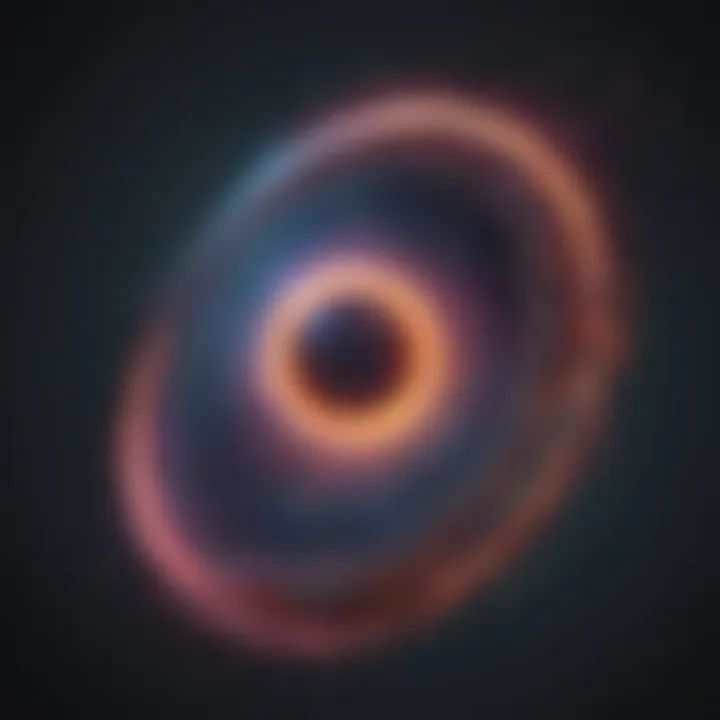Unraveling the Enigmatic Depths of Quanta Physics: A Comprehensive Exploration


Understanding the Depths of Quanta Physics
The Fundamental Principles of Quanta Physics
To grasp the essence of quanta physics, one must comprehend its fundamental principles that govern the behavior of particles at the quantum level. Concepts such as wave-particle duality, Heisenberg's uncertainty principle, and Schrödinger's wave equation form the bedrock of quantum theory, laying the groundwork for a paradigm shift in our perception of the physical world. These principles not only elucidate the behavior of subatomic particles but also shape the very fabric of the quantum realm.
Quantum Mechanics and Wave Function Collapse
Central to the study of quanta physics is the enigmatic theory of quantum mechanics, which provides a mathematical framework for understanding the behavior of particles at the quantum level. The wave function, a key component of quantum mechanics, encapsulates the probabilistic nature of particles and their states. When a measurement is made, however, the wave function collapses, leading to a definitive outcome—an aspect that continues to confound scientists and stir debates within the realm of quantum theory.
Applications of Quanta Physics in Modern Technology
Beyond the theoretical realm, quanta physics finds practical application in a myriad of modern technologies that shape our daily lives. Quantum computing, quantum cryptography, and quantum sensors are just a few examples of how the principles of quanta physics are harnessed to revolutionize fields such as data processing, secure communication, and sensing capabilities. As research in these areas progresses, the potential for quantum technologies to redefine the limits of human innovation becomes increasingly apparent.
Unraveling the Mysteries of Quantum Entanglement
Among the most intriguing phenomena in quanta physics is quantum entanglement, a phenomenon where two particles become interconnected in such a way that their states are correlated, regardless of the distance separating them. Einstein famously referred to this peculiar connection as 'spooky action at a distance,' reflecting the profound implications of entanglement on our understanding of space, time, and the nature of reality itself. The exploration of entanglement continues to captivate researchers as they probe the boundaries of quantum mechanics and its implications for the broader field of physics.
Synthesizing the Depths of Quanta Physics
Introduction to Quanta Physics
Quanta physics, a realm of scientific inquiry that challenges conventional understanding, serves as the cornerstone for various technological advancements and theoretical explorations. In this article, we peel back the layers of complexity surrounding this enigmatic field, striving to provide clarity and insight into its fundamental principles and far-reaching implications.
Understanding the Basics
Nature of Quanta
The nature of quanta embodies the discrete and indivisible units that form the basis of quantum theory. These entities, existing in superposition until observed, usher in a paradigm shift from classical mechanics to the probabilistic nature of quantum phenomena. The essence of quanta lies in its ability to exist in multiple states simultaneously, posing challenges to conventional cognition yet opening doors to unprecedented computational capabilities.
Dual Nature of Particles
The dual nature of particles encapsulates the wave-particle duality principle, wherein entities exhibit both wave-like and particle-like behavior depending on the experimental setup. This fundamental aspect underscores the interconnectedness between energy and matter, laying the groundwork for understanding the elusive behavior of particles at the quantum level. While this duality concept remains a remarkable feat of scientific theorization, its complexities offer profound insights into the nature of reality.
Wave-Particle Duality
Wave-particle duality illuminates the intriguing phenomena where entities, such as photons and electrons, manifest characteristics of both waves and particles. This phenomenon challenges traditional notions of determinism and underscores the probabilistic nature of quantum entities. The wave-particle duality concept not only expands our comprehension of quantum behavior but also triggers profound philosophical inquiries into the nature of existence and observation.
Key Principles
Quantum Superposition
Quantum superposition refers to the phenomenon wherein quantum systems exist in a combination of multiple states until observed, reflecting the multiplicity inherent in quantum mechanics. This principle serves as the foundation for quantum computing's exponential processing power, leveraging the richness of probabilities to outperform classical computational models. The versatility of superposition in information processing underscores its significance in revolutionizing technological landscapes, propelling us into an era of unprecedented computational efficiency.


Entanglement
Entanglement signifies the entwined correlation between quantum particles, irrespective of spatial separation, where the state of one particle instantaneously influences the state of its entangled counterpart. This phenomenon defies classical intuitions, revealing the interconnectedness pervading the quantum realm and harboring potential applications in secure communication protocols and quantum information processing. The enigmatic nature of entanglement continues to captivate scientists and innovators, promising groundbreaking advancements in various fields of study.
Quantum Tunneling
Quantum tunneling facilitates the passage of particles through energy barriers they classically cannot surmount, showcasing the probabilistic nature of quantum systems. This phenomenon enables electron transport in semiconductors, underpins nuclear fusion processes, and embodies the essence of quantum mechanics' unpredictability. While quantum tunneling poses challenges in material stability and computational accuracy, its ability to transcend conventional barriers fuels innovations in diverse scientific domains, shaping the forefront of technological progress.
Key Concepts in Quanta Physics
In this section, we will delve deeper into the key concepts that form the foundation of quanta physics. Understanding these concepts is paramount to grasp the intricate nature of the quantum world. We will explore the significance of Quantum Mechanics and Quantum Field Theory, unraveling their complexities and implications in this realm of physics.
Quantum Mechanics
Heisenberg Uncertainty Principle
The Heisenberg Uncertainty Principle is a fundamental concept in Quantum Mechanics, introducing a level of uncertainty into the measurement of complementary observables like position and momentum. This principle underscores the limitations in simultaneously determining these properties with precision. Its unique feature lies in the fact that the more accurately we measure one variable, the less precisely we can know the other, challenging classical notions of determinism. This principle's inclusion in this article is pivotal as it sheds light on the inherent uncertainty at the quantum level, prompting a reevaluation of our classical understanding of the physical world.
Schrodinger's Cat
Schrodinger's Cat presents a thought experiment highlighting the concept of superposition in quantum systems. The cat exists in a quantum superposition of being both alive and dead until observed, demonstrating the bizarre yet intriguing nature of quantum states. This bizarre scenario is beneficial for this article as it exemplifies the peculiar behaviors exhibited by particles at the quantum level, setting the stage for further exploration into the depths of quanta physics.
Quantum Entanglement
Quantum Entanglement is a phenomenon where two or more particles become correlated to the extent that the state of one instantly influences the state of the other, regardless of the distance separating them. This eerie connection challenges our conventional understanding of space and time, offering a potential avenue for future advancements in quantum technologies like quantum teleportation and quantum computing. Its presence in this article serves to illuminate the interconnectedness of particles at the quantum level and the implications it carries for communication and computation.
Quantum Field Theory
Virtual Particles
Virtual particles are fleeting entities that emerge from the vacuum due to quantum fluctuations and often play a vital role in particle interactions. These particles, despite being temporary, contribute significantly to the intricate dance of particles in quantum interactions. Their inclusion in this article provides insight into the dynamic and ever-changing nature of the quantum world, demonstrating the underlying mechanisms that govern particle behavior.
Higgs Field
The Higgs Field, associated with the Higgs boson, gives particles their mass, offering a profound explanation for the origin of mass in the universe. This field permeates the cosmos, dictating how particles acquire mass and interact with the Higgs boson. Its significance in this article lies in elucidating the mechanisms behind mass generation, a crucial aspect of particle physics with far-reaching implications for our understanding of the universe.
Quantum Electrodynamics
Quantum Electrodynamics is the quantum field theory describing the electromagnetic force, unifying quantum mechanics with electromagnetism. This theory is essential for understanding the behavior of light and matter at the quantum level, providing a comprehensive framework for electromagnetic interactions. Its discussion in this article offers a glimpse into the elegant fusion of quantum theory and electromagnetism, paving the way for deeper insights into the fundamental forces shaping the universe.
Applications of Quanta Physics
Embarking on the comprehensive exploration of quanta physics is incomplete without analyzing its crucial applications. The realm of quanta physics extends far beyond theoretical discussions; its practical implementations play a vital role in various sectors. From quantum computing to quantum teleportation, the applications of quanta physics are revolutionizing technology and science. Understanding these applications sheds light on the immense potential and futuristic implications of quantum mechanics.


Quantum Computing
Qubits:
In the domain of quantum computing, Qubits are pivotal building blocks that redefine computational capabilities. Unlike classical bits that exist in either 0 or 1 states, Qubits capitalize on quantum superposition, allowing them to be in multiple states simultaneously. This inherent property of Qubits exponentially increases processing power, enabling quantum computers to tackle complex problems with unparalleled efficiency. Despite facing challenges such as decoherence, Qubits stand out as the fundamental element driving innovation in quantum computing.
Quantum Algorithms:
Quantum Algorithms represent the algorithms tailored for quantum computers, leveraging quantum phenomena like entanglement and superposition. These algorithms exhibit exceptional efficiency in solving specific computational dilemmas by exploiting quantum parallelism. Their adaptability to quantum systems renders them highly sought after in advancing fields like cryptography, optimization, and machine learning. While still in nascent stages, Quantum Algorithms offer a promising avenue for addressing intricate challenges in a quantum-powered world.
Superposition and Entanglement in Computing:
The utilization of superposition and entanglement in computing embodies a paradigm shift in information processing. Superposition enables quantum systems to hold multiple states simultaneously, significantly boosting computational capacity. On the other hand, entanglement establishes correlations between particles regardless of distance, leading to instantaneous communication and exponential data processing. Harnessing these quantum phenomena in computing architectures unveils a new era of speed and efficiency, fostering innovations in various technological landscapes.
Quantum Teleportation
Quantum Information Transfer:
Quantum Information Transfer is a cornerstone of quantum teleportation, facilitating the transmission of quantum states between distant entities. This process leverages quantum entanglement to replicate quantum information without actual physical movement, promising secure and instantaneous data transfer. The unique feature of quantum information transfer lies in its ability to teleport information while preserving its quantum properties, a feat unattainable by classical methods. Embracing this aspect of quantum teleportation opens avenues for secure communications and futuristic networking.
Entangled Particles:
Entangled Particles lie at the heart of quantum teleportation, showcasing interconnected states that remain correlated even when separated by vast distances. The entanglement phenomenon allows for synchronized behavior between entangled particles, enabling the instantaneous transfer of information beyond classical limitations. While entanglement poses challenges in maintaining coherence, its potential for encrypted communication and high-speed data transmission elevates it as a crucial asset in quantum teleportation protocols.
Quantum Encryption:
Quantum Encryption stands out as a robust method for securing confidential information in the quantum realm. By employing quantum key distribution and leveraging the principles of quantum mechanics, quantum encryption ensures unparalleled security against eavesdropping and data breaches. The distinct feature of quantum encryption lies in its ability to detect any attempt at intercepting data, guaranteeing the confidentiality and integrity of transmitted information. Embracing quantum encryption paves the way for innovative approaches to safeguarding sensitive data in an era where cyber threats are increasingly sophisticated.
Theoretical Implications
Exploring the realm of Theoretical Implications in Quanta Physics opens up a gateway to understanding the profound implications that quantum phenomena have on our perception of reality and existence. This section delves into the significance of how theoretical frameworks shape our comprehension of the quantum world, paving the way for innovative paradigms and interpretations. By scrutinizing the theoretical underpinnings of quantum mechanics, readers can grasp the intricate tapestry of possibilities that emerge when delving into the depths of quantum phenomena.
Many-Worlds Interpretation
The Many-Worlds Interpretation introduces a captivating perspective on the nature of reality, proposing the existence of parallel universes coexisting with our own. In this theoretical framework, each quantum event branches into multiple outcomes, giving rise to a myriad of parallel realities. This concept challenges conventional notions of causality and suggests a vast multiverse where every quantum possibility manifests into its reality, presenting a mind-bending exploration of the quantum landscape. The concept of parallel universes offers a thought-provoking lens through which to contemplate the interconnectedness of quantum states and the enigmatic nature of existence.
Parallel Universes
Exploring the concept of Parallel Universes unveils a staggering idea where every decision point spawns alternative realities, creating a rich tapestry of potential worlds. The key characteristic of Parallel Universes lies in the infinite diversity of outcomes that result from quantum events, reflecting the boundless nature of quantum superposition. This theoretical construct presents a tantalizingly complex yet intellectually stimulating approach to understanding the vast array of possibilities inherent in quantum interactions.
Infinite Realities
Delving into the concept of Infinite Realities sheds light on the vast expanse of potential existences that could stem from each quantum event. The significance of Infinite Realities lies in transcending the confines of a singular, deterministic universe and embracing the idea of an infinite array of coexisting realities. This notion challenges preconceived notions of a fixed reality, inviting contemplation on the boundless nature of quantum variability and the rich tapestry of realities that could potentially unfold.


Branching Timelines
The idea of Branching Timelines introduces an intriguing narrative where each quantum event engenders a divergence in the fabric of reality, leading to the creation of distinct timelines. The key characteristic of Branching Timelines is the notion of diverging paths stemming from quantum interactions, offering a compelling exploration of the multiplicity of potential futures that could emerge. This concept opens up a fascinating discourse on the fluidity of time and the intricate interplay between quantum events and the unfolding of divergent timelines.
Copenhagen Interpretation
The Copenhagen Interpretation delves into the intricate role of the observer in shaping quantum phenomena, delving into the profound implications of measurement and interaction in quantum systems. This interpretation posits that quantum states exist in a superposition of possibilities until observed, leading to the collapse of the wave function and the emergence of a definite measurement outcome. By focusing on the observer's pivotal role in quantum systems, the Copenhagen Interpretation raises fundamental questions about the nature of reality and the relationship between observation and quantum reality.
Observer Effect
The Observer Effect explores the transformative impact of observation on quantum systems, highlighting the delicate balance between the observer's presence and the quantum phenomenon under scrutiny. The key characteristic of the Observer Effect is the intrinsic link between observation and the collapse of the wave function, showcasing how the act of measurement influences the manifestation of a specific quantum state. This phenomenon underscores the intricate connection between the observer and the observed, underscoring the intricate dance between perception and reality in the quantum realm.
Wave Function Collapse
Examining the Wave Function Collapse reveals a pivotal juncture in quantum mechanics where the superposition of quantum states transitions into a definite outcome upon observation. The significance of Wave Function Collapse lies in the abrupt shift from probabilistic outcomes to a singular, observable result, marking a transformative moment in quantum measurement. This concept underscores the ephemeral nature of quantum states and the crucial role of measurement in eliciting a precise quantum state from a realm of potentialities, emphasizing the intricate interplay between quantum superposition and observable reality.
Quantum Measurements
Quantum Measurements illuminate the process by which quantum systems interact with the measuring apparatus, leading to the evaluation of specific quantum properties. The key characteristic of Quantum Measurements lies in the precise quantification of quantum states through observable quantities, shedding light on the intricate act of observing quantum phenomena. This aspect underscores the crucial role of measurement in extracting information from quantum systems, underscoring the intricate nature of quantum interactions and the transformative effects of observation on the quantum landscape.
Current Research and Future Prospects
This section delves into the crucial realm of current research and future prospects in the field of quanta physics. As technology advances rapidly, understanding the current trends and potential future developments is vital. Researchers and scholars are actively delving into unifying quantum mechanics and general relativity, a monumental task that holds the promise of revolutionizing our understanding of the universe. These endeavors aim to blend the principles governing the very minute particles with the vast fabric of spacetime, offering a unified framework to explain the mechanics of the cosmos.
Quantum Gravity
Unifying Quantum Mechanics and General Relativity
Unifying quantum mechanics and general relativity represents a monumental effort to bridge the microscopic world of particles and the macroscopic realm of gravity. This ambitious goal seeks to harmonize the seemingly conflicting principles governing the tiny quantum particles with the curvature of spacetime dictated by mass and energy. By merging these two pillars of modern physics, scientists aspire to unlock the secrets of black holes, understand the origins of the universe, and perhaps even glimpse parallel dimensions.
Gravitons
Gravitons, the hypothetical particles carrying the force of gravity, play a pivotal role in the quest to understand quantum gravity. These elusive particles are postulated to mediate gravitational interactions at the quantum level, offering a glimpse into how gravity might behave on the smallest scales. While gravitons remain elusive and challenging to detect, their existence is crucial in constructing theoretical frameworks that combine gravity with quantum mechanics, paving the way for a deeper understanding of the fundamental forces in the universe.
String Theory
String theory, a theoretical framework aiming to describe the fundamental particles and forces as tiny strings vibrating at different frequencies, holds immense potential in the realm of quantum gravity. This captivating theory proposes that everything in the universe, from particles to forces, arises from the vibrations of these minuscule strings. By incorporating gravity into the fabric of string theory, physicists hope to resolve the discrepancies between general relativity and quantum mechanics, offering a coherent description of the universe at both the microscopic and cosmic scales.
Quantum Biology
Photosynthesis
Photosynthesis, the process by which plants and certain microorganisms convert light energy into chemical energy, represents a fascinating intersection of quantum physics and biology. At the heart of photosynthesis lies the intricate dance of light-absorbing molecules that harness quantum coherence to achieve remarkable efficiency in energy transfer. The quantum principles at play in photosynthesis have inspired researchers to explore novel ways of harvesting solar energy and creating innovative technologies that mimic nature's elegant efficiency.
Quantum Cognition
Quantum cognition posits that cognitive processes in the brain may involve quantum phenomena, opening up new horizons in understanding human consciousness and decision-making. By applying quantum principles to cognitive science, researchers seek to unravel the mysteries of intuition, creativity, and decision processes in a manner that transcends classical explanations. Exploring the potential quantum nature of cognition offers fresh insights into the complexities of the human mind and the underlying mechanisms guiding our thought processes.
Biophotons
Biophotons, the faint emissions of light emitted by living organisms, illuminate the fascinating field of quantum biology. These ultra-weak photon emissions emanate from biological systems and are believed to play a role in cellular communication and signaling processes. The study of biophotons unveils the quantum nature of biological systems, shedding light on the subtle interactions occurring within living organisms at the quantum level. Understanding the role of biophotons may pave the way for innovative diagnostic tools and therapies that harness the quantum properties of living systems.



